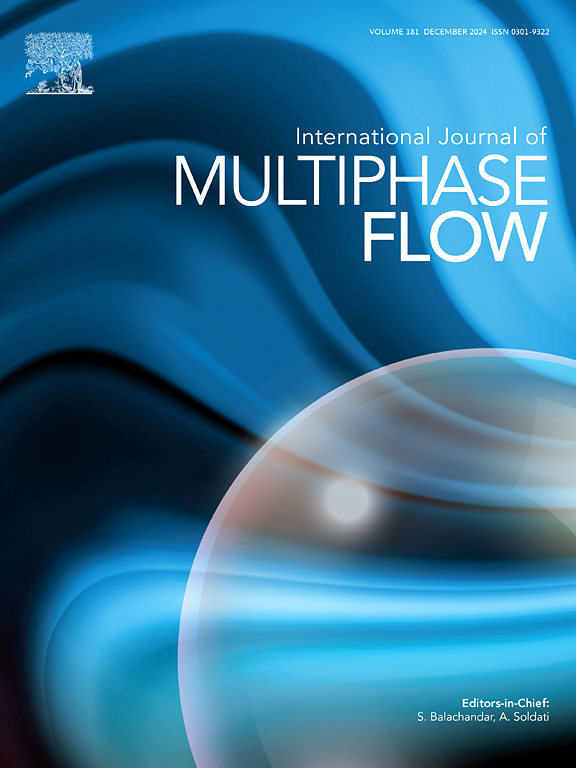耗散尺度中性浮力粒子对水平振荡网格产生的近似各向同性湍流调制效应的实验研究
IF 3.6
2区 工程技术
Q1 MECHANICS
International Journal of Multiphase Flow
Pub Date : 2025-01-22
DOI:10.1016/j.ijmultiphaseflow.2025.105144
引用次数: 0
摘要
研究耗散尺度粒子的湍流调制效应对于建立更精细的粒子负载两相湍流相间相互作用模型至关重要。利用粒子图像测速技术(PIV)测量了振荡网格产生的近似各向同性湍流,研究了耗散尺度中性浮力粒子的湍流调制。在本研究研究的网格运动参数范围内,湍流积分长度尺度约为1 cm,而泰勒微尺度比积分尺度小约一个数量级。湍流耗散尺度为188 ~ 1358 μm。实验研究了直径为150 μm、270 μm和500 μm的颗粒对各向同性湍流的影响,颗粒体积分数为0 ~ 0.1%,属于稀载颗粒湍流。研究发现,在近似各向同性湍流中,粒子表现出能量耗散、储存和再分布的效应。粒子还能够吸收二次平均流的能量,并通过粒子-流体相互作用将其转化为湍流涨落能量。这些机制共同构成了粒子对湍流的调制。颗粒耗散、储存和重新分配能量的能力随颗粒直径的变化而变化,使得颗粒体积分数的影响与颗粒直径的相对大小密切相关。总的来说,当颗粒尺度大于湍流耗散尺度时,颗粒倾向于增强湍流,反之亦然。由于粒子的存在改变了湍流耗散尺度,因此粒子尺度与湍流耗散尺度的相对大小是影响粒子诱导湍流调制的一个重要参数,但不是唯一的参数。对颗粒周围局部流场的观测表明,当颗粒直径小于湍流耗散尺度时,颗粒周围的流动结构仍以湍流为主。然而,较大的颗粒支配着周围的流动结构,导致它们周围的速度轮廓排列更有序。本文章由计算机程序翻译,如有差异,请以英文原文为准。

Experimental study on the modulation effect of dissipation scale neutrally buoyant particles on approximate isotropic turbulence generated by horizontal oscillating grids
Investigating the turbulent modulation effects due to dissipation scale particles is essential for the development of a more refined interphase interaction model for particle-laden two-phase turbulence. This study used Particle Image Velocimetry (PIV) to measure the approximately isotropic turbulence generated by oscillating grids, and investigated the turbulence modulation of dissipation scale neutrally buoyant particles. In the range of grid motion parameters studied in this research, the turbulence integral length scale is approximately 1 cm, while the Taylor microscale is about an order of magnitude smaller than the integral scale. The turbulence dissipation scale ranges from 188 to 1358 μm. Experiments were conducted to investigate the effects of particles with diameters of 150 μm, 270 μm, and 500 μm on isotropic turbulence, with particle volume fractions ranging from 0 to 0.1%, which make the flow belongs to dilute particle-laden turbulence. It was found that in the approximate isotropic turbulence, particles exhibit the effects of energy dissipation, storage, and redistribution. Particles are also capable of absorbing the energy from the secondary mean flow and converting it into turbulent fluctuation energy through particle-fluid interactions. These mechanisms together constitute the modulation of turbulence by particles. The ability of particles to dissipate, store, and redistribute energy varies with particle diameter, making the influence of particle volume fraction closely related to the relative size of the particle diameter. Overall, when the particle scale is larger than the turbulence dissipation scale, the particles tend to enhance the turbulence, and vice versa. Since the presence of particles alters the turbulence dissipation scale, the relative size of the particle scale to the turbulence dissipation scale is an important but not the only parameter influencing particle-induced turbulence modulation. Observations from the local flow field around the particles indicate that when the particle diameter is less than the turbulence dissipation scale, the flow structures surrounding the particles remain dominated by turbulence. However, larger particles dominate the surrounding flow structures, leading to a more orderly arrangement of velocity contours around them.
求助全文
通过发布文献求助,成功后即可免费获取论文全文。
去求助
来源期刊
CiteScore
7.30
自引率
10.50%
发文量
244
审稿时长
4 months
期刊介绍:
The International Journal of Multiphase Flow publishes analytical, numerical and experimental articles of lasting interest. The scope of the journal includes all aspects of mass, momentum and energy exchange phenomena among different phases such as occur in disperse flows, gas–liquid and liquid–liquid flows, flows in porous media, boiling, granular flows and others.
The journal publishes full papers, brief communications and conference announcements.

 求助内容:
求助内容: 应助结果提醒方式:
应助结果提醒方式:


